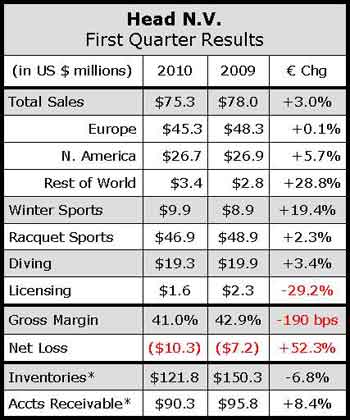Head NV saw strength in all three of its primary business segments drive single digit revenue growth for the second quarter ended June 30, although certain expenses expanded the company’s net loss by more than 50% for the reporting period.
Net revenues increased 3.0% in euro terms to €59.0 million ($45 mm) from €57.3 million ($48 mm) in the year-ago period, an increase the company attributed to increased sales volumes in the Winter Sports division and the strengthening of the U.S. dollar against the euro during the comparable period.

On a regional basis, revenues in Europe inched up 0.1% to €35.5 million ($45 mm) in the second quarter. In Europe, sales in the home country Austria region were basically flat at €16.8 million ($21 mm), while Italy grew 2.5% to €10.3 million ($13 mm) and the rest of Europe saw revenues decline 2.7% to €8.3 million ($11 mm). North America, which made up 35.4% of total sales in the second quarter versus 34.5% of sales in Q2 last year, posted sales growth of 5.7% in euro terms to €20.9 million ($27 mm). In U.S. dollar terms sales were down 1.0% for the period. Asia revenues jumped 28.8% off of a small base, posting sales of €2.6 million ($3 mm) for the quarter.
Winter Sports division revenues increased 19.4% to €7.8 million ($10 mm) in the second quarter from €6.5 million ($9 mm) in the comparable 2009 period, which Head attributed to higher sales volumes. The company said the 2009/2010 winter season started with early snow in Europe and in some parts of the U.S. but with late snow in Japan.
Retailers in Europe reported a growing winter sports equipment business mainly driven by accessories and skiwear. Head said ski sales in Europe have been flat compared to 2008 and “significantly down” in Japan and in Canada. Good snow conditions across the globe from January through the rest of the season led to “some good sell through also in Japan and retailers could reduce their inventory.”
Based on the final read on pre-season orders, management suggested that Winter Sports division sales will “overachieve last year’s sales” even as the company sees a “significant trend” towards renting ski equipment leading to a “still slightly declining equipment market.”
Racquet Sports revenues increased 2.3% to €36.7 million ($47 mm) from €35.9 million ($49 mm) in the prior-year period due to “higher sales volumes of tennis balls as well as the strengthening of the U.S. dollar against the euro partially offset by an unfavorable product mix resulting from the launch of new tennis racquets during the second quarter 2009.”
Management said it believe that the tennis market has slightly declined in the first half of 2010, with the U.S. market posting a decline of 2% in unit sales, but revenue increasing 7% based on many new product launches. The global European markets are expected to have declined in the first half of the year, “particularly following very bad weather conditions in most markets during the crucial spring tennis season.” For the first four months of the year, the Japanese market declined by approximately 4%, according to a Head quarterly report.
Diving segment revenues increased 3.4% to €15.1 million ($19 mm) in the second quarter from €14.6 million ($20 mm) in the year-ago period due to the later start of the diving season in Europe until mid-June last year caused by bad weather conditions.
Management said despite slight improvement for the quarter, consumer wariness related to high price points had contributed to a fractional first half decline.
The U.S. diving market is flat as a result of “a slow recovery from the worldwide economic crisis,” with dive equipment at higher price-points affected more so than softgoods. Head said it believes that Mares gained market share in its key European markets in Germany, France and Spain as a result of “innovative product launches and improved operations.”
Licensing, which accounts for around 2% of total revenues, decreased 29.3% to €1.2 million ($2 mm) for the three-month period.
Gross margin decreased 190 basis points to 41.0% of sales in Q2 due to “increased raw material costs in part due to the impact of the strengthening U.S. dollar against the euro and unfavorable product mix.” SG&A expenses were flat at 50% of net sales for the quarter.
The resulting net loss expanded 52.3% to €8.0 million ($10 mm), compared to a net loss of €5.3 million ($7 mm) in the prior-year period.














